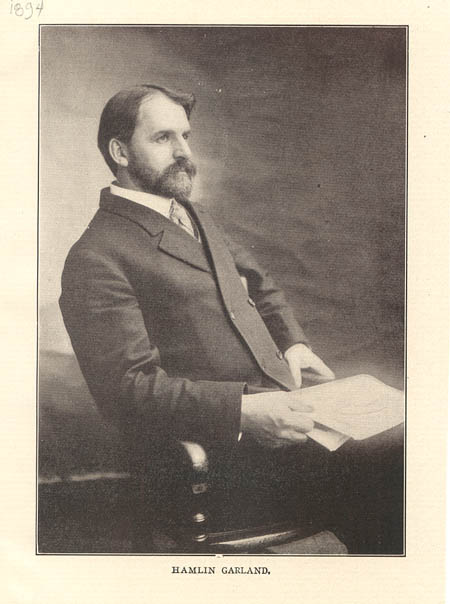Collection Guide
This document describes a Manuscript Collection held by the
Special Collections DepartmentUniversity of Iowa Libraries
e-mail: lib-spec@uiowa.edu

Guide Contents
Biographical and Historical Information
Scope and Contents of the Collection
Administrative Information
Access and
Restrictions:
Biographical Note
Hannibal Hamlin Garland was born near Salem, Wisconsin in 1860. He and his family moved to Iowa in 1869 settling first in Winneshiek County and moving to Burr Oak Township in Mitchell County shortly thereafter. On his family's farm in Mitchell County Garland is said to have done a man's work, but with apparent flair, sometimes wearing kid gloves and a frock coat to do chores. From 1875 until 1881 Garland lived Osage, Iowa while attending the Cedar Valley Seminary. Despite extreme poverty Garland was an excellent student. After graduating with honors from the seminary Garland taught school in Illinois for one year before setting out to travel the country with his brother. Hearing his father speak about Boston convinced him that this city was the center of learning in America and Garland traveled to Boston in 1884 to pursue a literary career. Finding that he could not afford to attend a university, he is said to have read every available book in the Boston Public Library. Teaching private classes in English and American Literature, Garland made many influential friends including Oliver Wendell Holmes, Henry Ford, John D. Rockefeller, and Lorado Taft. While living in Boston, Garland became an advocate for the improvement of farm conditions in the rural Midwest.
While teaching and lecturing, he started to publish. He wrote short stories for publication in such journals as Arena and Harper's Weekly. He gathered some of these stories and some previously unpublished stories to create, in 1890, Main-Travelled Roads, probably his most critically acclaimed book. In 1898, after completing a biography of Ulysses S. Grant commissioned by Samuel S. McClure, Garland went on a six-month expedition through the Yukon Valley. Upon his return, Garland married Zulime Taft, daughter of Don Carlos Taft and sister of Lorado. Garland had two daughters with Zulime, Mary Isabel and Constance.
He continued to publish over the next three decades, including autobiographical works such as Boy Life on the Prairie (1908), A Son of the Middle Border (1917) and A Daughter of the Middle Border (1921) for which he won the Pulitzer prize for biography in 1922. He championed the cause of Native Americans and women, subjects which made their way into his writings. He ventured into literary criticism with Crumbling Idols (1894). Garland believed in a version of realism that he called veritism, which involved showing life as it was, including the squalor, unhappiness, and sometime desperation of common people. He believed that local color stories were the national literature of America, and this is what he practiced. He was disappointed, therefore, when people of the Midwest attacked his stories, and he retreated into writing Rocky Mountain romances.
Although most famous as a novelist, writing more than forty books, Garland was also an accomplished poet, essayist, short-story writer, and lecturer. For more than forty years Garland lectured on American history and authors. After moving to Hollywood, California in 1929 Garland authored two final books concerning psychic research and phenomenon; Forty Years of Psychic Research (1936) and The Mystery of the Buried Crosses (1939). Garland died on March 4, 1940 in California.
A. Neville, J. Roethler, August 2005
Scope and
Contents
This small collection consists of four short manuscripts,
biographical materials, some photographs, clippings, correspondence, and few
items of miscellany.Photographs:
Related Materials
Papers of Ellis Parker Butler, University of Iowa Special Collections
Wisconsin
Electronic Reader
Acquisition and Processing
Information
Guide posted
to Internet:
Biographical information.
Cliff Dwellers Club newsletters. Fine arts club organized by Hamlin Garland
Clippings, mostly undated
Correspondence
Folder 1
Adams, Dr.
Adcock, St. John. 15 letters
Ainsworth, Ed. 6 letters
Aley
Baxter, Mr.
Blodgett, Mr.
Borland, Hal
Canby, Mr.
Castle, Mr.
Chamberlin, Joseph Edgar
Clemens, Cyril. 14 letters
Folder 2
Connelly, John R.
Coonley [ Lydia Avery]. 22 letters
Edgett, Edwin Francis
Editor of Bookman
Editor of “The Indian’s Friend”
Gessler, Clifford
Granberg, Fred
Grant, Mr.
Green, Prof. F.H.
Greenway, Mr.
Greenway, Reverend Cornelius
Grey, Zane. 2 letters
Griffin
Griffith, Mr.
Grossman, Mrs.
Harrison, Harry P. 6 letters
Hickok, Mr.
Higginson, Colonel
Holt, Dr. Hamilton. 2 letters
Hubbard [Elbert]
Johnson, ?
Lipkin, Miss
Folder 3
MacManus, Mr.
Markham, [Edwin]
Martin, Mr.
Members of the Advisory Committee, American Academy of Arts and Letters
Meyer, Mrs.
Meyn, ?
Nesbit, Mr.
Norris, Edward Everett. Includes a flyer for Garland's lectures
O’Brien, Miss
Perkins, Mr.
Reading, Mr. 5 letters
Redding, Judge (Same as Mr. Reading?)
Renland, Orlando
Rice, Wallace
Robb, Ellis
Robinson, Doane
Rudyard, Charlotte. 3 letters
S, Mr.
Shambaugh, Bertha and Benjamin. 3 letters
Shortledge, A.G.
Spiering
Stoddart, [Joseph M.]
Stone, Herbert Stuart.4 letters
Tunnicliffe, Mrs. Robert
Unknown. 2 letters
Wray, Henry Russell
Young, Art
Manuscripts
"Americanisms in Fiction"
"Daniel Beard"
"Mark Twain"
"Robert Frost"
Miscellaneous
Application for a library card, Boston Public Library
Inscription to Harold [Williams?]
Main Travelled Roads dust jacket
Publicity materials for Isabel Garland's Joint Recital of Poetry and Song, undated
Four photographs of Garland with Irving Bachelor
The Garlands at home, 1936
Garland, ca. 1937 (2 photographs)
Publicity photo, ca. 1930 (with negative)
Press release and proofs for Garland's biography of Ulysses S. Grant for McClure's Magazine, 1896.
Promotional booklets from publisher, The Macmillan Company.
Two editions; contains reviews, essays, photos, illustrations, and a chronology
of Garland's life.
Research papers about Hamlin Garland
Boudreau, Richard. The Land of the Straddle Bug. University of Wisconsin at LaCrosse. Undated.
Carter, Joseph. The Westward Compulsion and Garland's The Trail of the Goldseekers. Alliance College. Undated.
Davis, Jack L. Hamlin Garland's Indians and the Quality of Civilized Life. University of Idaho. Undated.
Love, Glen A. Progressivism and the New Westerner in Hamlin Garland's Mountain Novels. University of Oregon. Undated.
